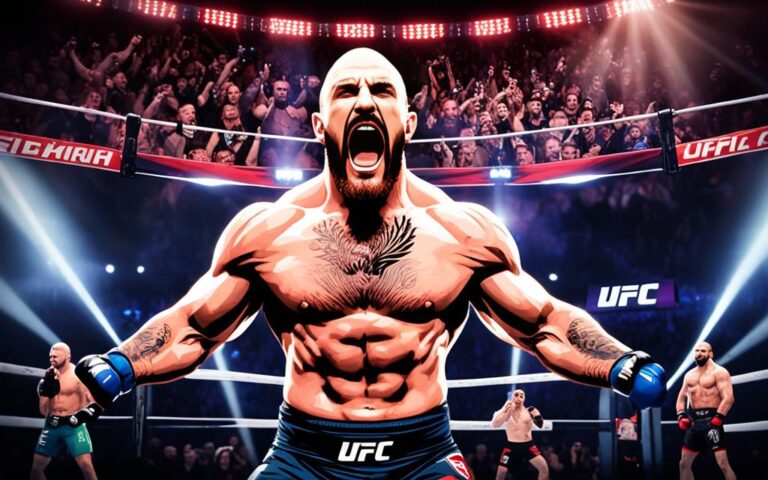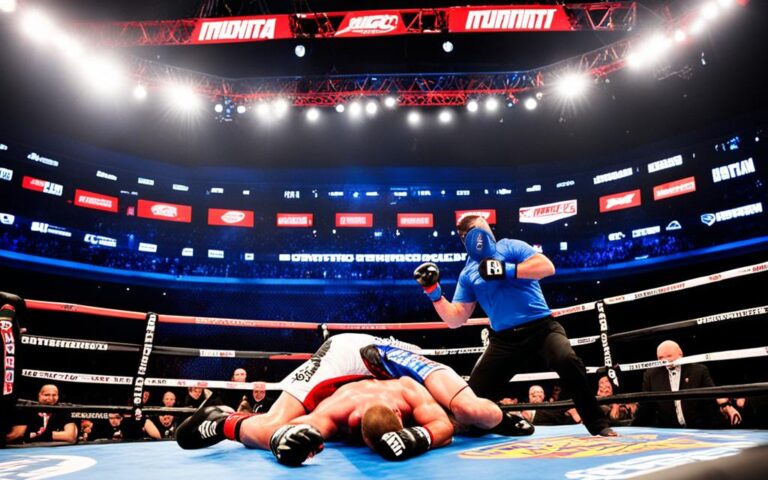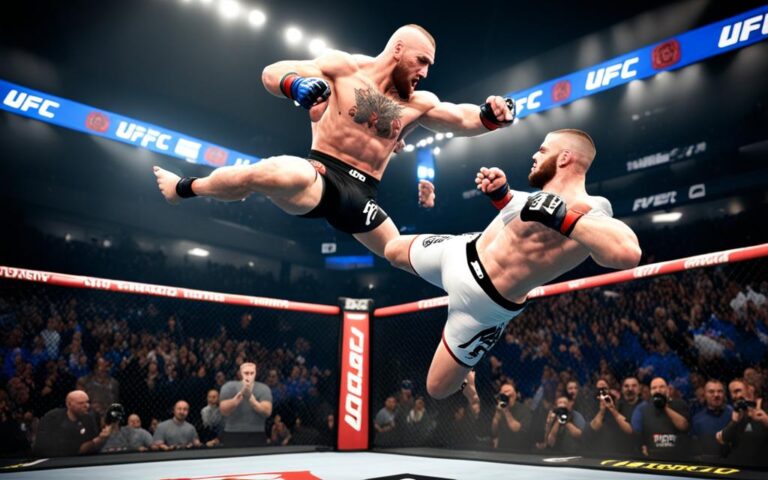In UFC 4, a fighter’s size can really impact how they do in the octagon. Statistician Reed Kuhn found that in the 25-foot cage, fights are more likely to end in a knockout or submission. In this smaller space, fighters throw about 20% more strikes, which makes them more involved in the fight.
This change means fighters have to adjust their strategies. Some like the smaller cage because it can lead to more wins. But those in heavier weight classes might find it hard to move and prefer the 30-foot cage. The cage size in UFC 4 really matters and shows how well fighters can adapt, no matter their size.
Stepping into UFC 4, we see that size truly makes a difference. The octagon is where small changes can decide who wins and who loses. Let’s look at how size and strength play out in UFC 4. We’ll discover that, in the world of mixed martial arts, being small doesn’t always mean you’ll lose.
The Influence of Size and Strength in UFC 4
Size and strength really matter in UFC 4. But winning doesn’t just come from being big and powerful. The puzzle of how these are linked to victory is complex.
Big fighters do pack a punch. They can push their way through a fight. But the little guys have a secret weapon – speed and nimbleness. They use their quickness to win almost 50% of the time against opponents much larger than them.
Fighting smart is a big deal in UFC 4. Knowing how to move, not just hit hard, is crucial. Dodging blows and staying calm can beat brute force. UFC 4 loves fighters who think as much as they fight.
“It’s not just about how big and strong you are,” says UFC fighter Conor McGregor. “It’s about how you use your strengths and exploit your opponent’s weaknesses. UFC 4 is a game that allows you to showcase your skills and prove that size doesn’t always determine the outcome.”
Little fighters in UFC 4 use their quickness to win. They’re like ninjas, dodging attacks and striking back fast. Their size lets them find gaps in their opponent’s defence. Using their speed, they can beat bigger foes.
Prominent Examples of Size vs. Skill in UFC 4
Anderson Silva vs. Forrest Griffin: Silva had amazing skills and beat the bigger Griffin. Silva dodged and struck with precision, leading to a clear win.
Dominick Cruz vs. T.J. Dillashaw: Cruz’s fancy footwork and smart moves outdid Dillashaw, who was bigger. Cruz’s quickness and plan got him the victory.
Demetrious Johnson vs. Henry Cejudo: Johnson faced the larger Cejudo. But Johnson’s quickness, technique, and smart fighting overpowered Cejudo, showing size isn’t everything.
In UFC 4, being big and strong does help, but it’s not everything. Skills, plans, and the power to change the game matter a lot. Everyone has a chance to win, regardless of size, in UFC 4. It’s a game where true fighters of any size excel.
| Fighter | Weight Class | Size (Height) | Strength |
|---|---|---|---|
| Conor McGregor | Lightweight | 5’9″ | Explosive Striking |
| Jon Jones | Light Heavyweight | 6’4″ | Versatile Skillset |
| Khabib Nurmagomedov | Lightweight | 5’10” | Wrestling Dominance |
| Amanda Nunes | Women’s Bantamweight | 5’8″ | Punching Power |
Unleashing the Underdog: How Size Doesn’t Always Determine the Outcome
In UFC 4, a fighter’s size isn’t the final word on who will win. Big fighters do have physical strength over smaller ones. But the smaller fighters use their smarts and techniques to win despite this. They react quickly to their opponent’s moves and find ways to outsmart them.
This is a big change from what we see in nature, where the bigger ones usually win. In UFC 4, the spirit of fighting lets everyone have a chance at success. It’s about the skills you have and the will to win, not just your size. Being smaller can even be an advantage. This shows that in the UFC’s world, being powerful isn’t the only way to win.
The debate over size and skill is always on in MMA, especially in UFC 4. It shows that any fighter, big or small, can do something amazing in the ring. UFC 4 is a stage for all fighters to show what they’ve got. It’s a celebration of the strategies and guts of those who fight against big odds. Even though size matters, it’s not everything in the UFC 4 world.
FAQ
How does the size of a fighter impact their performance in UFC 4?
A fighter’s size matters a lot in UFC 4. The fights in a smaller 25-foot diameter cage can end quickly. This leads to more knockouts or submissions. In this setup, fighters throw more punches, around 20 percent more.
Do heavier weight classes find it more difficult to navigate the smaller cage in UFC 4?
Heavier weight classes do find it harder in the smaller cage. They usually fight in larger 30-foot cages. These are used for big events to give more space.
Are smaller fighters at a disadvantage in UFC 4?
Not really. Smaller fighters have speed and agility on their side. They win about half the time against bigger foes. This success is thanks to their smart moves, tactics, and quickness.
How do smaller fighters overcome their size disadvantage in UFC 4?
Small fighters use their skill and strategy to beat the odds in UFC 4. They move fast and smart, which helps them win. This clever fighting makes up for their size.
Can smaller fighters slip punches and predict opponents’ actions better in UFC 4?
They can. Smaller fighters are good at avoiding hits and guessing their foe’s moves. Their speedy reactions give them an upper hand. This helps them fight better against bigger rivals.
Does size determine the outcome of fights in UFC 4?
Not all the time. Big fighters might be strong, but smaller ones can use their minds to win. Skill and strategy play a big part in who wins the fight, not just size.


















